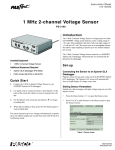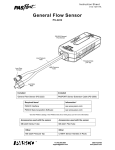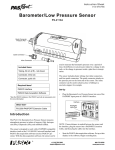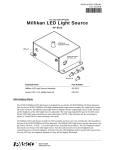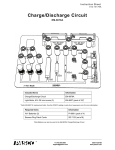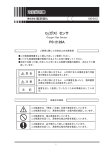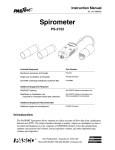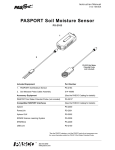Download PASCO Specialty & Mfg. PS-2126A User's Manual
Transcript
Instruction Sheet 012-11736B *012-11736* Oxygen Gas Sensor PS-2126A sensor amplifier rubber stopper Oxygen Sensing Element Life: sensing element connecting cable sampling bottle Included Equipment Part Number Sensor Amplifier PS-2126A (includes sensing element) Oxygen Sensing Element (with deflector) 699-299 Rubber Stopper 699-08186 Connecting Cable (3.5 millimeter) 514-08583 Sampling Bottle 650-064 Required Equipment PASPORT Interface See PASCO catalog or www.pasco.com Introduction The PS-2126A Oxygen Gas Sensor measures oxygen gas concentration in percent (%) and parts per million (ppm) oxygen. It can be used to study plant, animal, or cellular respiration; air quality; and the rate of oxygen (O2) production in chemical reactions (see the experiment on page 2 for one example). Galvanic fuel cells have a limited lifetime which is determined by their age and their exposure to oxygen. This is similar to the life of a battery in a flashlight. If the flashlight frequently used, the battery life will not be as long as it would have been with limited usage. Similarly, the fuel cell’s useful life is determined by its exposure to oxygen gas. The fuel cell included with the PS-2126A has a useful life of 900,000 oxygen percent (O2 %) hours. An example: If the sensor is used in a 100% oxygen atmosphere, the life of the sensor may be calculated as 900,000 O2 % hours divided by 100% oxygen which is 9,000 hours. This is about 1 year. The life of the sensor in normal air (20.9% oxygen) is 900,000 O2 % hours divided by 20.9% oxygen which is 43,062 hours. This is about 4.9 years. The sensor is guaranteed for a minimum of 2 years from the date of manufacture. This is the absolute guarantee. If it is used in a 100% oxygen atmosphere its life will be shortened. If it is used in normal air, its life will be 4 to 5 years. There is reported evidence of this particular sensing element being in use for almost 10 years. In the end, the useful life of the sensing element is dependent on the manner in which it is used. Setup Connect the Oxygen Gas Sensor to your PASPORT interface. How it works: To prepare the Oxygen Sensing Element for use: The Oxygen Sensing Element is a galvanic fuel cell with a gas permeable membrane at one end. It is very similar to a battery. The fuel cell contains an electrolyte, anode and cathode. When oxygen enters the fuel cell through the membrane, a chemical reaction between the metallic cathode and anode and the electrolyte occurs. This chemical reaction produces a voltage and current that is present at the output jack at the other end of the Oxygen Sensing Element. The current produced is proportional to the concentration of oxygen present. 1. Remove the Oxygen Sensing Element and deflector from the packaging. 2. Remove the pink tape from the Oxygen Sensing Element. 3. Carefully thread the deflector onto the Oxygen Sensing Element. 4. Slide the rubber stopper over the deflector. ® Model No. PS-2126A C o l l e c t i n g O 2 S a m p le s Calibration 5. Plug one end of the connecting cable into the Oxygen Sensing Element. 6. Plug the other end of the connecting cable into the Sensor Amplifier. The sensor is factory calibrated. However, for greater accuracy, you can follow these steps to calibrate the sensor: 7. Connect the Sensor Amplifier to the PASCO interface. 1. 8. Refer to the documentation that came with the PASCO interface and software for further instructions for data collection. With the sensor connected to a powered PASPORT interface, place the sensing element in the empty sampling bottle. Outside air has an O2 concentration 20.9%. 2. Press the CAL (20.9%) button on the sensor and hold it for 3 seconds. The green light will flash on and off for 4 seconds, indicating that calibration is in progress. 3. After 4 seconds, the reading will stabilize at 20.9%. When calibration is complete, the light will stop flashing. Collecting O 2 Samples To collect an atmospheric sample, hold the bottle upright and open to the air. Insert the end of the sensing element into the bottle. Press the rubber stopper into the neck to seal the bottle. To collect expired air or other gas samples, place the sensing element inside a plastic bag. Press any atmospheric air out of the bag. Use a tube to fill the bag with the gas sample. Hold, tie, or clamp the bag closed round the tube and sensing element cable to contain the gas sample and exclude atmospheric air. When doing an experiment that requires a faster than usual response time, the response time of the sensor may be increased by removing the white deflector and stopper from the Oxygen Sensing Element. This shortens the path to the sensor's membrane allowing it to be populated more rapidly with the sample. The purpose of the white deflector is to deflect air from an air stream into the sensing element and provide protection for the gas permeable membrane. It also holds the rubber stopper. While the white deflector is removed from the sensing element, be careful not to place sharp objects near the membrane as puncturing the membrane could lead to damage to the sensing element and electrolyte leaking from the membrane. Removal of the deflector is not required or recommended during typical operating conditions. Warning: Do not allow the sensing element to contact liquids. Note: If the green light flashes rapidly after calibration, the sensing element may be expired and it may need replacement. Experiment: Oxygen Production from Liver Catalase Equipment required: Oxygen Gas Sensor with sampling bottle, beef or chicken liver, hydrogen peroxide, pipette, mortar and pestle, ice bath, boiling water, and safety goggles. Safety: Always wear safety goggles when performing this experiment. Do not allow excessive pressure to develop in the sampling bottle. 1. Place the liver in an open container and allow it to warm to room temperature. 2. (Optional) Calibrate the Oxygen Gas Sensor (see above). 3. Grind the liver to a mushy consistency. 4. Place 10 mL of hydrogen peroxide into the clean, dry sampling bottle. Note: Perform step 5 through 7 carefully and quickly. 5. With a pipette, extract 1 mL of blood/homogenate from the ground liver and release it into the sampling bottle. 6. Insert the end of the sensing element into the bottle. Press the rubber stopper into the neck of the bottle just enough to close the bottle, but not too tightly 7. Start data collection on the computer or interface. 8. After about 300 seconds, stop data collection. 9. Clean and dry the sampling bottle. Repeat steps 4 through 8 with cold liver homogenate that has been chilled in an ice bath. Repeat again with liver homogenate that has been boiled in water. 10. Compare your results from the three runs. ® 2 Model No. PS-2126A Specifications Range 0 to 100% O2 concentration 0 to 1000000 parts per million (ppm) Resolution 0.025% oxygen Repeatability ±0.5% oxygen Accuracy ±1% O2 at constant temperature and pressure; ±5% O2 over operating temperature range Sensing Element Maintenance Storage: Operating temperature 0 to 40 °C Relative humidity range 0 to 100%, non-condensing Sensing element useful life 4+ years Sensing element warranty period 24 months The Oxygen Sensing Element may be stored in its package until its first use. It is recommended that the sensing element be stored with the threaded nose piece in the downward position. This insures that the electrolyte remains in contact with the membrane for extended periods of storage. Sensor life may be extended by storing the sensing element in a refrigerator at 40ºF to 50ºF (4°C to 10°C). Do not freeze the sensor or sensing element. Technical Support For assistance with any PASCO product, contact PASCO at: Address: PASCO scientific 10101 Foothills Blvd. Roseville, CA 95747-7100 Phone: 916-786-3800 (worldwide) 800-772-8700 (U.S.) Fax: (916) 786-3292 Web: www.pasco.com Email: [email protected] Limited Warranty: For a description of the product warranty, see the PASCO catalog. Copyright: The PASCO scientific 012-11736B Oxygen Gas Sensor Instruction Sheet is copyrighted with all rights reserved. Permission is granted to non-profit educational institutions for reproduction of any part of this manual, providing the reproductions are used only in their laboratories and classrooms, and are not sold for profit. Reproduction under any other circumstances, without the written consent of PASCO scientific, is prohibited. Trademarks: PASCO, PASCO scientific, DataStudio, PASPORT, Xplorer Xplorer GLX, SPARK, and SPARKvue are trademarks or registered trademarks of PASCO scientific, in the United States and/or in other countries. For more information visit www.pasco.com/legal. ® 3



